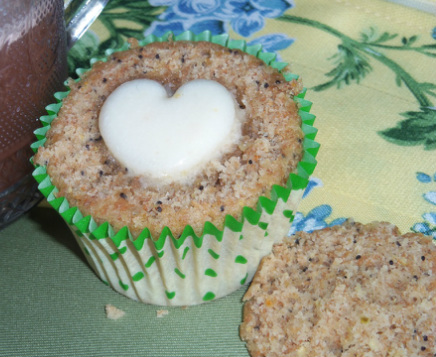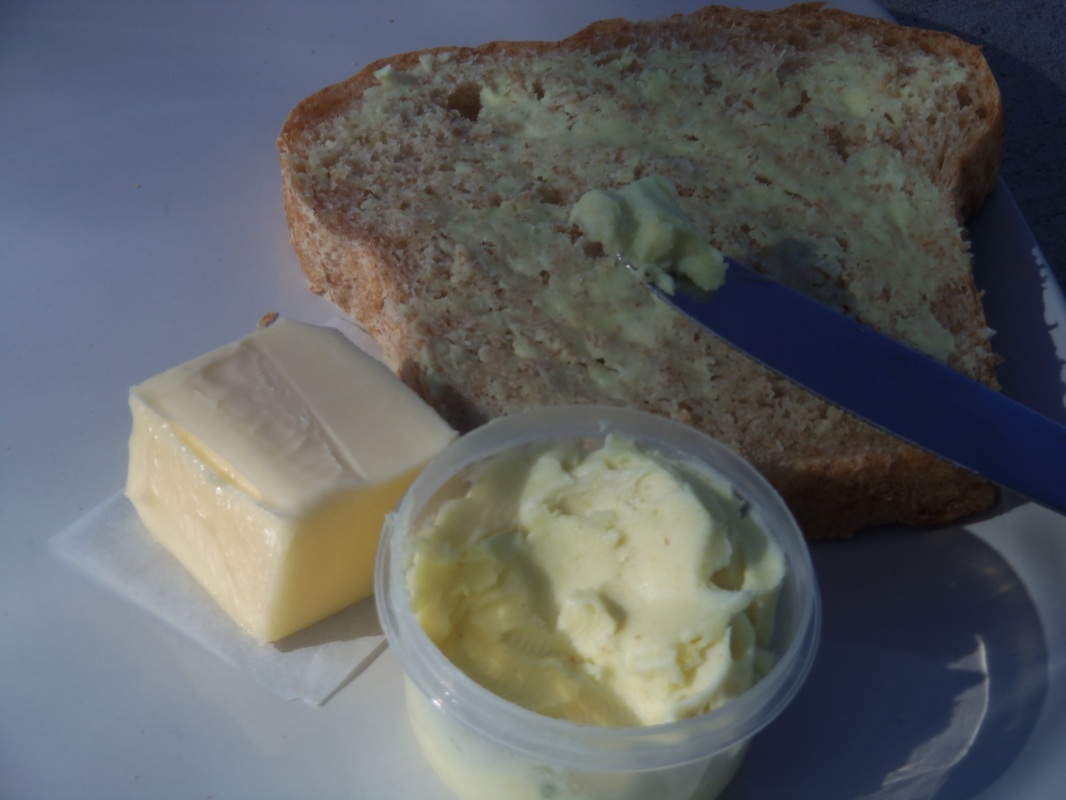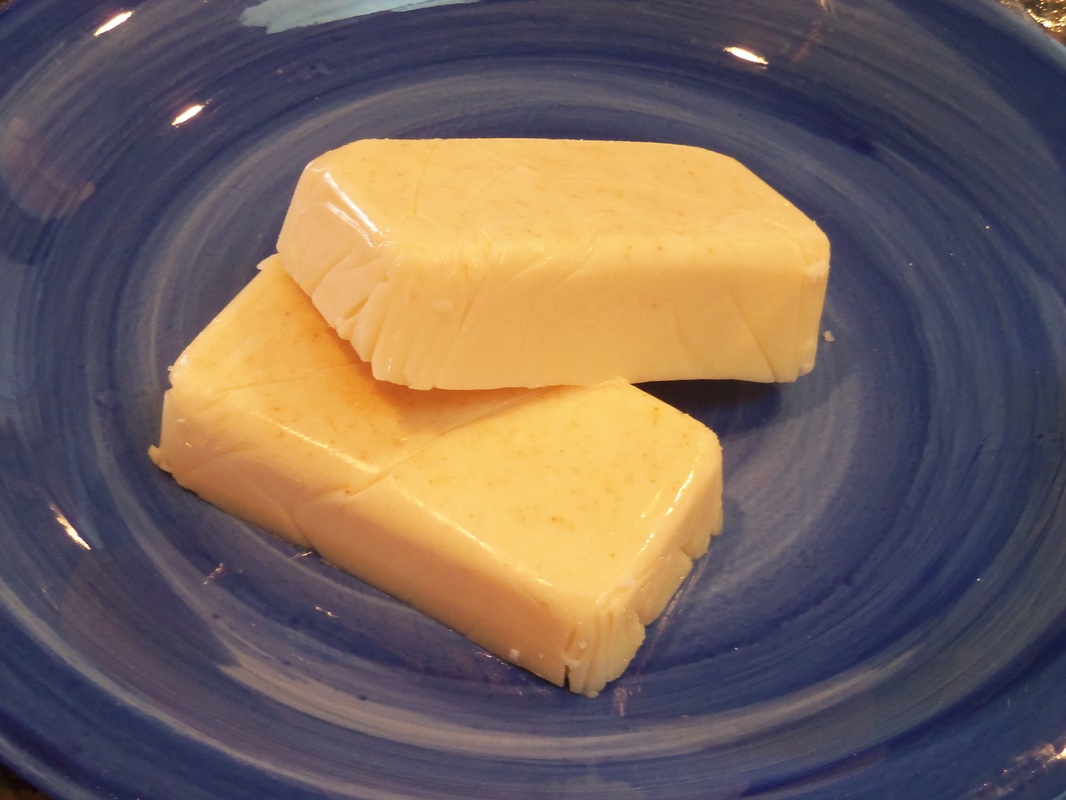But first- if you've noticed a shift towards gluten-free and dairy-free recipes lately, good noticing! I. Love. Dairy. I even milked a cow every day as a teenager so I had the fresh great stuff. But sometimes people have health problems with certain foods. So far we've discovered that two of my children get stomach aches when they drink milk. One of my daughters has excema on her arms that just has not cleared up. It usually comes and goes, especially in the winter, but she's had it for two months straight. So I've taken all dairy and wheat items out of her diet to see if those common allergens could be a reason for it. I'm still cooking normally for everyone else, but have necessarily been experimenting with this other way of cooking. And here's the latest and greatest:
Butter. Sort of. It tastes like it, anyway. And spreads beautifully. It even cooks like butter. I've creamed it with sugar and made a cake, made brownies, melted it on muffins, spread on toast, made honeybutter, and made dairy-free cream of broccoli soup with it. Yum.
The idea was sparked by reading a label on a small tub of honey butter. Turns out there was no butter in it at all, but tasted as though it did. Reading through the list- hydrogenated soybean oil, honey, citric acid, soy lecithin, artificial colors and flavors- it occurred to me that if THEY could make something taste and spread like butter, then maybe I could, too. So I started researching what the flavor components were in butter and what other foods contain them too. It was fun to read about- ketones, diacetyl, acetoin, reactions between aldehyde and niacin. (But, dang it, how come if I was setting a good example of work, study, and loving to learn, I had to remind my daughter every 20 minutes to get back to her schoolwork?!)
Anyway, I found some foods that naturally have some of the same flavor components as butter, and used one that covered the bases. It's the ingredient that makes ALL the difference in flavor here. Liquid aminos. Or just use soy sauce, which is about the same thing. If you prefer to avoid soy completely, nutritional yeast flakes will give a similar flavor. Vinegar also works, in the same tiny amount. The cornstarch, coconut flour, or xantham gum thicken the water so it will better stay mixed with the oils.
This is spreadable when used straight from the fridge. It’s fantastic on toast, muffins, and waffles. It has about the same fat-to-water ratio as dairy butter (80:20). You can cook with it just like real butter, too. It can be creamed with sugar for cakes and cookies. Use it cold from the fridge to do this, and don’t beat it longer than about 45 seconds or it begins to melt a little. This spread can be mixed with an equal amount of honey to make honey butter.
If you’d like a firmer consistency, like sticks of butter, increase coconut oil to ¾ cup and reduce liquid oil to ¼ cup.
Turmeric and paprika give it a nice color without affecting the flavor. Turmeric adds bright yellow so a little goes a long way, and paprika lends a warm pinkish orange. Both will deepen after a day. Combine a pinch of each (just under 1/16 tsp) for the best color. If you make this using olive oil, the buttery spread has a greenish hint to it which paprika helps eliminate.
Dairy-free Buttery Spread
2 Tbsp. water
1 tsp. cornstarch OR coconut flour OR 1/4 tsp. xantham gum
1/8 tsp. liquid aminos or soy sauce or vinegar OR scant ½ tsp. nutritional yeast
½ tsp. salt
A pinch each turmeric and paprika, optional (for color)
½ c. coconut oil, softened just til creamy and stirrable
½ c. olive oil or other liquid oil like canola
In a glass 1-cup measuring cup, stir together water and coconut flour. Microwave until it boils, stir until smooth. (You’ll need 3 T water if boiling this in a pan on the stove.) Mix in the liquid aminos, salt, turmeric and paprika. Set aside to cool.
After it’s cooled to nearly room temperature, mix in the coconut oil, then whisk in olive oil until smooth. Put mixture in the fridge to chill. Stir after it starts to thicken, about 15-30 minutes.
Store covered in the refrigerator. Makes just over 1 cup. (9 ½ oz, or 3 T. more than 2 sticks of butter)
If you want a firmer consistency to form “sticks” of butter, after it’s just started thickening in the fridge and you’ve stirred it, pack it into whatever molds you have. I use mini loaf pans, filling them on a scale so each stick weighs 4 ounces. Put in the freezer to solidify. After they’re hard, pop them out of the molds and store in ziptop bags or wrapped in plastic. Label and keep in the freezer for longer storage, or keep in the fridge for shorter-term use.



 RSS Feed
RSS Feed